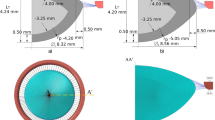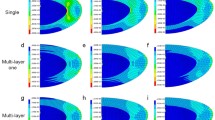Abstract
Published data on the mechanical performance of the human lens capsule when tested under uniaxial and biaxial conditions are reviewed. It is concluded that two simple phenomenological constitutive models (namely a linear elastic model and a Fung-type hyperelastic model) are unable to provide satisfactory representations of the mechanical behaviour of the capsule for both of these loading conditions. The possibility of resolving these difficulties using a structural constitutive model for the capsule, of a form that is inspired by the network of collagen IV filaments that exist within the lens capsule, is explored. The model is implemented within a rectangular periodic cell. Prescribed stretches are imposed on the periodic cell and the network is allowed to deform in a non-affine manner. The performance of the constitutive model correlates well with previously published test data. One possible application of the model is in the development of a multi-scale analysis of the mechanics of the human lens capsule.
Similar content being viewed by others
References
Barnard K, Burgess SA, Carter DA, Woolley DM (1992) Three-dimensional structure of type IV collagen in the mammalian lens capsule. J Struct Biol 108(1): 6–13
Belaidi A, Pierscionek BK (2007) Modeling internal stress distributions in the human lens: can opponent theories coexist?. J Vis 7(11): 1–12
Bonet J, Wood RD (1997) Nonlinear continuum mechanics for finite element analysis. Cambridge University Press, Cambridge
Burd HJ, Judge SJ, Cross JA (2002) Numerical modelling of the accommodating lens. Vis Res 42(18): 2235–2251
Cavalcante FSA, Ito S, Brewer K, Sakai H, Alencar AM, Almeida MP, Andrade JS Jr, Majumdar A, Ingenito EP, Suki B (2005) Mechanical interactions between collagen and proteoglycans: implications for the stability of lung tissue. J Appl Physiol 98(2): 672–679
Chandran PL, Barocas VH (2006) Affine versus non-affine fibril kinematics in collagen networks: theoretical studies of network behavior. J Biomech Eng 128(2): 259–270
Chandran PL, Barocas VH (2007) Deterministic material-based averaging theory model of collagen gel micromechanics. J Biomech Eng 129(2): 137–147
Crisfield MA (1996) Non-linear finite element analysis of solids and structures: essentials, vol 1. Wiley, London
Danielsen CC (2004) Tensile mechanical and creep properties of Descemet’s membrane and lens capsule. Exp Eye Res 79(3): 343–350
David G, Humphrey JD (2007) Finite element model of stresses in the anterior lens capsule of the eye. Comput Methods Biomech Biomed Eng 10(3): 237–243
David G, Pedrigi RM, Heistand MR, Humphrey JD (2007) Regional multiaxial mechanical properties of the porcine anterior lens capsule. J Biomech Eng 129(1): 97–104
Deshpande VS, Ashby MF, Fleck NA (2001) Foam topology: bending versus stretching dominated architectures. Acta Mater 49(6): 1035–1040
Dubbelman M, Van der Heijde GL, Weeber HA (2005) Change in shape of the aging human crystalline lens with accommodation. Vis Res 45(1): 117–132
Fisher RF (1969) Elastic constants of the human lens capsule. J Physiol 201(1): 1–19
Gathercole LJ, Barnard K, Atkins EDT (1989) Molecular organization of type IV collagen: polymer liquid crystal-like aspects. Int J Biol Macromol 11(6): 335–338
Hermans EA, Dubbelman M, van der Heijde GL, Heethaar RM (2006) Estimating the external force acting on the human eye lens during accommodation by finite element modelling. Vis Res 46(21): 3642–3650
Holzapfel GA (2000) Nonlinear solid mechanics: a continuum approach for engineering. Wiley, Chichester
Holzapfel GA, Gasser TC, Ogden RW (2000) A new constitutive framework for arterial wall mechanics and a comparative study of material models. J Elast 61(1–3): 1–48
Hutchinson RG, Fleck NA (2006) The structural performance of the periodic truss. J Mech Phys Solids 54(4): 756–782
Inoue S (1994) Basic structure of basement membranes is a fine network of ‘cords,’ irregular anastomosing strands. Micros Res Tech 28(1): 29–47
Inoue S, Leblond CP (1988) Three-dimensional network of cords: the main component of basement membranes. Am J Anat 181(4): 341–358
Knupp C, Squire JM (2005) Molecular packing in network-forming collagens. Adv Protein Chem 70: 375–403
Krag S, Andreassen TT (2003) Mechanical properties of the human lens capsule. Prog Retin Eye Res 22(6): 749–767
Krag S, Thim K, Corydon L, Kyster B (1994) Biomechanical aspects of the anterior capsulotomy. J Cataract Refract Surg 20(4): 410–416
Krag S, Olsen T, Andreassen TT (1997) Biomechanical characteristics of the human anterior lens capsule in relation to age. Invest Ophthalmol Vis Sci 38(2): 357–363
Kuhn K (1995) Basement membrane (type IV) collagen. Matrix Biol 14(6): 439–445
Lanir Y (1983) Constitutive equations for fibrous connective tissues. J Biomech 16(1): 1–12
Menapace R, Findl O, Kriechbaum K, Leydolt-Koeppl C (2007) Accommodating intraocular lenses: a critical review of present and future concepts. Graefe’s Arch Clin Exp Ophthalmol 245(4): 473–489
Onck PR, Koeman T, van Dillen T, van der Giessen E (2005) Alternative explanation of stiffening in cross-linked semiflexible networks. Phys Rev Lett 95(17): 178102
Ostoja-Starzewski M (2002) Lattice models in micromechanics. Appl Mech Rev 55(1): 35–59
Oyster CW (1999) The human eye: structure and function. Sinauer, Sunderland
Pedrigi RM, David G, Dziezyc J, Humphrey JD (2007) Regional mechanical properties and stress analysis of the human anterior lens capsule. Vis Res 47(13): 1781–1789
Pinsky PM, van der Heide D, Chernyak D (2005) Computational modeling of mechanical anisotropy in the cornea and sclera. J Cataract Refract Surg 31(1): 136–145
Rosen AM, Denham DB, Fernandez V, Borja D, Ho A, Manns F, Parel J-M, Augusteyn RC (2006) In vitro dimensions and curvatures of human lenses. Vis Res 46(6–7): 1002–1009
Sacks MS (2003) Incorporation of experimentally-derived fiber orientation into a structural constitutive model for planar collagenous tissues. J Biomech Eng 125(2): 280–287
Stachs O, Martin H, Behrend D, Schmitz KP, Guthoff R (2006) Three-dimensional ultrasound biomicroscopy, environmental and conventional scanning electron microscopy investigations of the human zonula ciliaris for numerical modelling of accommodation. Graefe’s Arch Clin Exp Ophthalmol 244(7): 836–844
Timpl R, Brown JC (1996) Supramolecular assembly of basement membranes. BioEssays 18(2): 123–132
Weeber HA, van der Heijde RGL (2007) On the relationship between lens stiffness and accommodative amplitude. Exp Eye Res 85(5): 602–607
Yurchenco PD (1994) Assembly of laminin and type IV collagen into basement membrane networks. Extracellular matrix assembly and structure. Academic Press, San Diego, pp 351–388
Yurchenco PD, Ruben GC (1987) Basement membrane structure in situ: evidence for lateral associations in the type IV collagen network. J Cell Biol 105(6): 2559–2568
Yurchenco PD, Schittny JC (1990) Molecular architecture of basement membranes. FASEB J 4(6): 1577–1590
Yurchenco PD, Tsilibary EC, Charonis AS, Furthmayr H (1986) Models for the self-assembly of basement membrane. J Histochem Cytochem 34(1): 93–102
Author information
Authors and Affiliations
Corresponding author
Rights and permissions
About this article
Cite this article
Burd, H.J. A structural constitutive model for the human lens capsule. Biomech Model Mechanobiol 8, 217–231 (2009). https://doi.org/10.1007/s10237-008-0130-5
Received:
Accepted:
Published:
Issue Date:
DOI: https://doi.org/10.1007/s10237-008-0130-5




